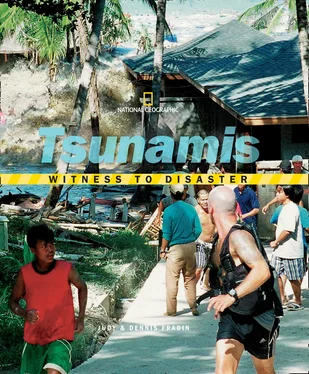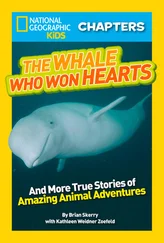National Kids - Witness to Disaster - Tsunamis
Здесь есть возможность читать онлайн «National Kids - Witness to Disaster - Tsunamis» — ознакомительный отрывок электронной книги совершенно бесплатно, а после прочтения отрывка купить полную версию. В некоторых случаях можно слушать аудио, скачать через торрент в формате fb2 и присутствует краткое содержание. Жанр: unrecognised, на английском языке. Описание произведения, (предисловие) а так же отзывы посетителей доступны на портале библиотеки ЛибКат.
- Название:Witness to Disaster: Tsunamis
- Автор:
- Жанр:
- Год:неизвестен
- ISBN:нет данных
- Рейтинг книги:4 / 5. Голосов: 1
-
Избранное:Добавить в избранное
- Отзывы:
-
Ваша оценка:
- 80
- 1
- 2
- 3
- 4
- 5
Witness to Disaster: Tsunamis: краткое содержание, описание и аннотация
Предлагаем к чтению аннотацию, описание, краткое содержание или предисловие (зависит от того, что написал сам автор книги «Witness to Disaster: Tsunamis»). Если вы не нашли необходимую информацию о книге — напишите в комментариях, мы постараемся отыскать её.
Witness to Disaster: Tsunamis — читать онлайн ознакомительный отрывок
Ниже представлен текст книги, разбитый по страницам. Система сохранения места последней прочитанной страницы, позволяет с удобством читать онлайн бесплатно книгу «Witness to Disaster: Tsunamis», без необходимости каждый раз заново искать на чём Вы остановились. Поставьте закладку, и сможете в любой момент перейти на страницу, на которой закончили чтение.
Интервал:
Закладка:
Tsunamis
WITNESS TO DISASTER
In the world there is nothing more submissive and weak than water. Yet for attacking that which is hard and strong, nothing can surpass it.
—Lao Tzu,
Chinese Philosopher
Tsunamis
WITNESS TO DISASTER
JUDITH BLOOM FRADIN & DENNIS BRINDELL FRADIN

Text copyright © 2008 Judith Bloom Fradin and Dennis Brindell Fradin
Published by the National Geographic Society.
All rights reserved. Reproduction of the whole or any part of the contents without written permission from the National Geographic Society is strictly prohibited.
Founded in 1888, the National Geographic Society is one of the largest nonprofit scientific and educational organizations in the world. It reaches more than 285 million people worldwide each month through its official journal, NATIONAL GEOGRAPHIC, and its four other magazines; the National Geographic Channel; television documentaries; radio programs; films; books; videos and DVDs; maps; and interactive media. National Geographic has funded more than 8,000 scientific research projects and supports an education program combating geographic illiteracy.
For more information, please call 1-800-NGS-LINE
(647-5463) or write to the following address:
National Geographic Society
1145 17th Street N.W.
Washington, D.C. 20036-4688
U.S.A.
Visit us online at www.nationalgeographic.com/books
For information about special discounts for bulk purchases, please contact National Geographic Books Special Sales: ngspecsales@ngs.org
For rights or permissions inquiries, please contact National Geographic Books Subsidiary Rights: ngbookrights@ngs.org
Library of Congress Cataloging-in-Publication Data available available on request.
ISBN: 978-1-4263-0980-9
National Geographic Society
John M. Fahey, Jr., President and Chief Executive Officer
Gilbert M. Grosvenor, Chairman of the Board
Tim T. Kelly, President, Global Media Group
Nina D. Hoffman, Executive Vice President; President, Book Publishing Group
Staff for This Book
Nancy Laties Feresten, Vice President, Editor-in-Chief of Children’s Books
Bea Jackson, Director of Design and Illustration Carl Mehler, Director of Maps
Amy Shields, Executive Editor
Jim Hiscott, Art Director
Lori Epstein, Illustrations Editor
Grace Hill, Associate Managing Editor
Priyanka Lamichhane, Assistant Editor
Lewis R. Bassford, Production Manager
Nicole Elliott, Manufacturing Manager
Jennifer A. Thornton, Managing Editor
R. Gary Colbert, Production Director
Susan Borke, Legal and Business Affairs
Photo Credits
Cover, John Russell/ AFP/ Getty Images; Back, Bettmann/ Corbis; spine, N. Silcock/ Shutterstock; 2-3, Rick Doyle/ Corbis; 5, Hermann M. Fritz, Georgia Institute of Technology; 6, Jose C. Borrero, University of Southern California; 8 both, IKONOS satellite imagery by GeoEye/ CRISP-Singapore; 9, AFP/ Getty Images; 10 both, Joanne Davis/ Polaris; 11 left & right, Joanne Davis/ Polaris; 11 bottom, Mark Pearson; 12, PH3 Tyler J. Clements, United States Navy; 13, Louis Evans, Curtin University of Technology; 14, Image: S. Lombeyda, Caltech Center for Advanced Computing Research; V. Hjorleifsdottir and J. Tromp, Caltech Seismological Laboratory; R. Aster, Reprinted with permission from Science Volume 308, Number 5725 (20 May 2005); 15, U.S. Geological Survey; 16, U.S. Geological Survey; 18, O.H. Hinsdale Wave Research Laboratory, Oregon State University; 19, Bretwood Higman, University of Washington; 20, NASA; 21 both, Koji Sasahara/ Associated Press; 22, Jose C. Borrero, University of Southern California; 24, Pacific Tsunami Museum; 27, Naval Historical Foundation; 29, Used with permission from the Stars and Stripes. © 1964, 2008 Stars and Stripes; 30, Corbis; 32, NOAA National Data Buoy Center; 33, NOAA West Coast and Alaska Tsunami Warning Center; 34, NOAA National Data Buoy Center; 35, Aaron Favila/ Associated Press; 36, NOAA National Data Buoy Center; 37, David Heikkila/ iStockphoto.com; 38, Tim Laman/ National Geographic Image Collection; 40-41, Adam Powell/ Taxi/ Getty Images; 42, Tatyana Makeyeva/ AFP/ Getty Images; 43, U.S. Geological Survey; 45, Bazuki Muhammad/ Reuters/ Corbis.
Version: 2017-07-06
CONTENTS
Introduction: Japan Tsunami
Chapter 1: “Like Niagara Falls Moving Towards Us”: Indian Ocean Tsunami of 2004
Chapter 2: “A Wave 800 Feet Tall”: Tsunami Science
Chapter 3: “Everything Had Become Sea”: Some Historic Tsunamis
Chapter 4: “Out of the Blue”: Tsunami Warnings and Safety
Glossary
Further Reading and Research
Bibliography
Interviews by the Authors
Acknowledgments
Index
Introduction: Japan Tsunami
On the afternoon of March 11, 2011, a humungous earthquake struck northeastern Japan. It measured 9.0 on the magnitude scale. Only three larger quakes have shaken our planet in the past century.
The earthquake occurred when two large chunks of our planet’s crust fractured beneath the sea off the coast of Japan. The rupture thrust part of the ocean floor under the island nation, dropping its coastline two feet while lifting the land beneath the sea. This double motion caused the Pacific Ocean waters to slosh like soup in a bowl, creating massive waves called tsunami.
Because Japan is one of the most earthquake-prone places on our planet, the Japanese people are well prepared for both earthquakes and tsunamis. Homes and large buildings in Japan are built to withstand large quakes. A state-of-the-art tsunami warning system is in place, and Japanese children and adults undergo regular drills to make sure they know what to do during such disasters.
But nothing could prepare the residents of northeastern Japan for the gigantic waves that hit their coast an hour and a half later. Walls of water as tall as 30 feet (9 meters)—the height of a three-story building—slammed into coastal Japanese cities at the speed of a jet airplane. The water flooded areas more than five miles inland, killing tens of thousands of residents.
The power of the water was so intense that tsunami warnings were issued for coastal Hawaii, 3,850 miles (6,200 kilometers) from Japan. Waves taller than three feet (one meter) high hit the Hawaiian coast seven and a half hours after the quake struck Japan.
Crescent City, California, lies 4,763 miles (7,700 kilometers) from the coast of Japan. Nevertheless, ten hours after the earthquake, an eight-foot (two-meter) tsunami wave slammed into that harbor city, destroying a pier and reducing dozens of boats to rubble.
Sophisticated tsunami warning systems throughout the Pacific Ocean prevented even greater loss of life. You will learn more about tsunamis and the systems that warn people about them in the following chapters.
CHAPTER 1
“Like Niagara Falls Moving Towards Us”
Indian Ocean Tsunami of 2004
On December 26, 2004, an earthquake shook our planet so violently that it wobbled slightly on its axis.
The quake struck shortly after dawn, beneath the floor of the Indian Ocean. Lasting about nine minutes, this was the third most powerful earthquake ever measured. It unleashed a natural disaster of almost unimaginable proportions.
A large earthquake that occurs beneath or near the ocean can violently disturb seawater, creating a series of waves collectively known as a tsunami. Out at sea, tsunami waves move at hundreds of miles per hour but appear as just bumps on the ocean’s surface. Approaching shore, they slow down dramatically, but can pile up into titanic walls of water. The December 26, 2004, earthquake triggered tsunami waves that raced toward the shores of more than a dozen countries along the Indian Ocean. Some locales were struck by waves up to 110 feet tall—the height of an 11-story building.
Читать дальшеИнтервал:
Закладка:
Похожие книги на «Witness to Disaster: Tsunamis»
Представляем Вашему вниманию похожие книги на «Witness to Disaster: Tsunamis» списком для выбора. Мы отобрали схожую по названию и смыслу литературу в надежде предоставить читателям больше вариантов отыскать новые, интересные, ещё непрочитанные произведения.
Обсуждение, отзывы о книге «Witness to Disaster: Tsunamis» и просто собственные мнения читателей. Оставьте ваши комментарии, напишите, что Вы думаете о произведении, его смысле или главных героях. Укажите что конкретно понравилось, а что нет, и почему Вы так считаете.












